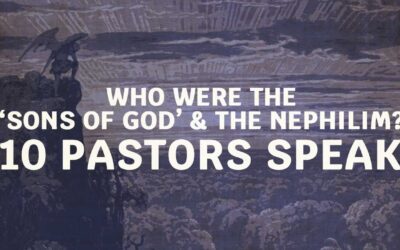Tim Chaffey is a Christian apologist and author who has published on the topics of the resurrection of Christ, creation/evolution, as well as quite a few books.
One topic he has worked on is the question of who are the ‘sons of God’ and Nephilim in Genesis?
His book, Fallen: The Sons of God and the Nephilim is one of the most balanced resources on the topic and I highly recommend it to anyone researching this topic.
Tim offers a great chart showing how this passage was interpreted over time by Jewish and Christian leaders, beginning in 250 BC and up to today. This is very helpful in understanding the historical backdrop that is not obvious to us immediately when researching this issue in our day.
Tim Chaffey on the Sons of God and the Nephilim
The Fallen Angel position is the most popular theory concerning the identity of the sons of God. This is clearly the earliest position that we know of. It was promoted in apocryphal works written before the time of Christ and by every church father who commented on it until the 3rd century.
Although the Fallen Angel view is repulsive to most, it is important to understand what the text actually states. The term “sons of God” is from the Hebrew bene ha ‘elohim. This particular term is only used three other times in Scripture and in each case, it clearly refers to heavenly beings.
While there are a handful of similar Hebrew phrases used in Scripture, these are the only four passages that mention this specific term.
Contrary to popular belief, the word “Nephilim” is not derived from the Hebrew verb “naphal” which can have the meaning “to fall.” It does not fit any of the proper forms (morphologies). So this is not primarily speaking about people who “fall on” others in the sense of being violent or about those who have “fallen” far from God, even though they were clearly in rebellion against God. Many use this line of argumentation to claim that the Nephilim were the “fallen ones.” Besides the fact that “Nephilim” does not mean “fallen ones,” it would not make a whole lot of sense to call the offspring “fallen ones” when in fact it would be their fathers (the “sons of God”) who were fallen.
The term “Nephilim” is in all likelihood not a Hebrew term at all. Instead, it is a plural form of the Aramaic noun (naphil) that means “giant.” (For a fairly easy-to-understand explanation of the origins of this term, please read Michael Heiser’s paper on the subject.) This is stated in the major Hebrew and Aramaic lexicons (Brown, Driver, Briggs / HALOT / NIDOTTE). This is why it is translated as giants in several translations and why the Septuagint (Greek translation of the OT) uses the term gigantes (giants). This also makes sense of Number 13:33 which tells us that the a race of giants known as the Anakim were part of the Nephilim. So why would the offspring of one group of humans marrying another group of humans result in giant offspring? Of course, it is genetically possible for a giant to be born if the parents had the appropriate genetics, but it seems highly unlikely that all of the offspring of these two groups would have been giants unless something more sinister was going on.
Tim Chaffey | Excerpts from The Sons of God and the Nephilim





